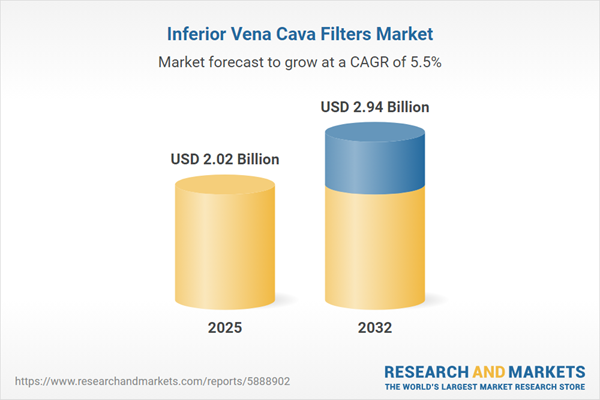Speak directly to the analyst to clarify any post sales queries you may have.
The Inferior Vena Cava Filters Market is undergoing substantive evolution, with recent advancements in device engineering, clinical protocols, and procurement strategies significantly impacting growth trajectories worldwide. Senior decision-makers navigating this complex environment require actionable insights to identify and capitalize on emerging opportunities within this dynamic segment.
Market Snapshot: Inferior Vena Cava Filters Market Overview
The Inferior Vena Cava Filters Market continues its upward path, fueled by ongoing innovation in filter design and expanded adoption in hospitals and outpatient settings. As providers align with evolving protocols for venous thromboembolism management, there is a notable increase in integration of these devices, particularly in regions prioritizing patient safety and resource optimization. This expansion highlights a global trend toward improved care delivery models, adaptive procurement, and operational readiness to meet changing clinical standards for vascular intervention.
Scope & Segmentation
This report breaks down key segments and their impact on informed decision-making for procurement and operations:
- Filter Types: Permanent filters deliver ongoing protection for at-risk patients, whereas retrievable filters support targeted interventions that address specific clinical scenarios.
- Material Types: Cobalt chrome brings durability for patients requiring extended use. Nitinol offers flexibility to accommodate varied anatomical needs. Stainless steel allows for broad application through scalable, cost-efficient solutions.
- End Users: Devices are deployed across ambulatory surgical centers, public hospitals, private health systems, and clinics, reflecting adoption in both acute care and chronic disease management environments.
- Indications: Deployments span from deep vein thrombosis prevention to pulmonary embolism management, serving both urgent and long-term risk reduction in high-complexity patient populations.
- Distribution Channels: Access is facilitated by hospital pharmacies, specialized e-commerce platforms, and select retail networks, supporting reach into diverse healthcare and regional systems.
- Geographical Regions: Distinct market trends are evident in the Americas, Europe, Middle East & Africa, and Asia-Pacific, with adoption shaped by regulatory and clinical practices in countries such as the United States, Canada, China, India, and Brazil.
- Key Companies: Major contributors include Becton Dickinson and Company, Boston Scientific Corporation, Cook Medical LLC, Cordis Corporation, Rex Medical, Teleflex Incorporated, and B. Braun Melsungen AG, all actively influencing product innovation, compliance, and competitive benchmarks.
Key Takeaways: Strategic Insights for Decision-Makers
- Improvements in filter technology and materials support enhanced clinical outcomes, enabling deployment across a broader range of scenarios and patient profiles.
- The transition to minimally invasive placement techniques reduces overall procedural complexity and supports streamlined workflows, advancing coordination in multidisciplinary teams.
- Rising regulatory expectations require more robust quality control systems and proactive approaches to patient safety, necessitating adaptive processes at every organizational level.
- Adjusting procurement strategies for evolving reimbursement and regulatory frameworks is critical for ensuring both compliance and sustained market positioning.
- Regionalized manufacturing and adaptive supply chain management contribute to greater operational resilience, especially in response to regulatory or logistical disruptions.
- Close collaboration with research entities and clinical experts ensures alignment with the latest clinical evidence, supporting accelerated technology uptake.
Tariff Impact: Responding to US Regulatory Changes
Recent changes in US regulation have prompted leading market participants to invest in domestic manufacturing while forging new partnerships with regional suppliers. These efforts are reducing operational expenditures and bolstering supply chain reliability, positioning organizations to respond swiftly to further regulatory or market shifts.
Methodology & Data Sources
This analysis integrates interviews with clinical and executive leaders, an extensive review of current literature, and comparative evaluations of regulatory standards. The cross-referenced approach ensures decision-makers receive dependable and relevant intelligence for developing effective strategies.
Why This Report Matters
- Enables healthcare executives to manage organizational risk, direct resources efficiently, and foster sustainable growth in a changing clinical landscape.
- Provides procurement and R&D leaders with a framework to identify technology-driven opportunities and spearhead operational improvements across care settings.
- Delivers accessible guidance for navigating regulatory complexities and market variations, ensuring robust positioning and continuous business continuity.
Conclusion
Strategic success in the Inferior Vena Cava Filters Market demands a balance of operational agility and meaningful partnership development. Emphasizing continuous innovation and process refinement will secure ongoing relevance in the evolving healthcare sector.
Additional Product Information:
- Purchase of this report includes 1 year online access with quarterly updates.
- This report can be updated on request. Please contact our Customer Experience team using the Ask a Question widget on our website.
Table of Contents
3. Executive Summary
4. Market Overview
7. Cumulative Impact of Artificial Intelligence 2025
Companies Mentioned
The companies profiled in this Inferior Vena Cava Filters market report include:- Becton Dickinson and Company
- Boston Scientific Corporation
- Cook Medical LLC
- Cordis Corporation
- Rex Medical, LLC
- Teleflex Incorporated
- B. Braun Melsungen AG
Table Information
| Report Attribute | Details |
|---|---|
| No. of Pages | 183 |
| Published | November 2025 |
| Forecast Period | 2025 - 2032 |
| Estimated Market Value ( USD | $ 2.02 Billion |
| Forecasted Market Value ( USD | $ 2.94 Billion |
| Compound Annual Growth Rate | 5.5% |
| Regions Covered | Global |
| No. of Companies Mentioned | 8 |









